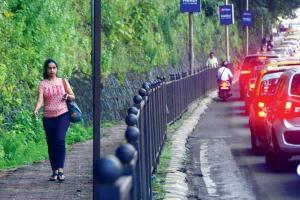A two-day seminar will discuss how Mumbai, despite the safe-for-woman badge of honour it wears, could do with immediate infrastructure tweaks

Footpath barricades at Kemps Corner. Pic/ Bipin Kokate
It has been eight years since Elsa Marie D'Silva launched Safecity, a-first-of-its-kind crowd map of personal stories of sexual violence in public spaces. Since then, the former aviation professional, has been at the forefront of creating awareness about safer spaces for women, through her non-profit, Red Dot Foundation. "From the crowd map, we learnt that sexual violence doesn't occur in isolation; it's the result of a combination of factors. In the stories we collected [12,000 at present], we identified why certain locations became comfort zones for perpetrators."
At a two-day Urban Thinkers Campus seminar, that's part of the UN Habitat's World Urban Campaign, Red Dot is inviting persons from government, business, civil society and the youth, to help design solutions to create public spaces that are safe from the gender and climate resiliency perspective. Climate and gender go hand in hand, says D'Silva. "The reason more women die in floods, is because they are either stuck in their homes, or caring for their children, or just don't know how to swim, because swimming is not considered a skill women should have," she says.
If you can't make it for the seminar, here are four suggestions from D'Silva to ensure a city makes its spaces more inclusive.

BKC, a zone of low activity after dark. Pic/ Rane Ashish
Remove footpath barricades:
D'Silva says several stretches are poorly lit and barricaded. "If you are attacked on an isolated footpath, and want to run from the perpetrator, the barricade is a hindrance." she says. "Neither can you exit nor reach out to somebody easily for help." This feeling of being hemmed in, often causes women to walk on busy streets—where there is moving traffic—over pedestrian-friendly sidewalks. In the process, they put their lives at risk. The other issue is of cars lining footpaths. "They block the view of the street and the light coming from centre islands. These areas then become hot-spots for drug peddlers and sexual predators."
Increase activity in isolated zones:
When planning and designing infrastructure, D'Silva says authorities should ensure that all kinds of people, not just men, can use it throughout the day. While Mumbai sees more women in public spaces than in other cities, there continue to be commercial zones, like BKC, where you don't see too many women after office hours. "You need to create a zone of activity in such neighbourhoods, which will draw more women. It's also important to consider the last mile connectivity," she says. In BKC, for instance, you need to walk a distance before you get to an auto or taxi stand. Several lanes are isolated post 8 pm.

Low lighting at Lower Parel. Pic/ Ashish Raje
The entry and exit points of railway stations are trouble spots. "Simple urban planning principles of painting them in brighter colours, could help," she suggests.
Improve lighting:
Dark and isolated stretches are notorious for criminal activity. "Recently, we held a corporate workshop where a woman reported an incident on the skywalk outside Grant Road West station. This is one of the costliest skywalks in the city and yet, dark and deserted in the evening," says D'Silva. "Women risk being touched and groped." For starters, these pockets need to be well lit, because "lighting is directly co-related to safety". "Trees on the road should also be regularly pruned so that they do not block street-lighting," she suggests.

Elsa Marie D'Silva
Re-think public infrastructure:
Though CCTV cameras have become the go-to solution to increase surveillance, D'Silva says, it is a lazy way of solving crime. "It is also dangerous, because they can be used to control people. CCTVs should only be placed in crowded places, where policing might be an issue. It's important to know what this data will be used for." She also suggests relooking at public furniture and traffic signals. "Non-functional signals are often linked to sexual violence. If women can't walk on the road easily, they become vulnerable."
When: November 25 and 26, 9.30 AM – 6 PM
Where: Indian School of Design and Innovation, Lower Parel
To register: info@safecity.in
Catch up on all the latest Mumbai news, crime news, current affairs, and also a complete guide on Mumbai from food to things to do and events across the city here. Also download the new mid-day Android and iOS apps to get latest updates
 Subscribe today by clicking the link and stay updated with the latest news!" Click here!
Subscribe today by clicking the link and stay updated with the latest news!" Click here!









